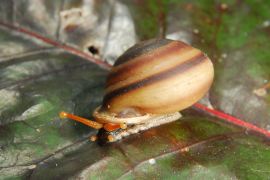
Pleurodonte (Dentellaria) bronni (Pfeiffer, 1846) - 18mm diameter; Photo: Richard L. Goldberg.
How important is limestone in the survival of snails? A dry scrub area along the north coast of Trelawny Parish, Jamaica was the site for a survey of the snails today. Most of the area was flat rubble rock leading up to a steep cliff face covered by foliage. Deep in the moist spaces between hand-size rubble rock covered up with dry leaf little were four species of snails, the largest being
Pleurodonte bronni, only known from Jamaica’s north central coastal region. No snails were found in the most disturbed areas near the road where a minimal amount of limestone rubble is exposed to the hot sun. Moving just a few feet away from the road towards the cliff face changed the numbers of snails observed.

The habitat of Pleurodonte bronni; limestone karst shaded by foliage; Photo: Richard L. Goldberg
Snails are habitat-specific, meaning they have preferences for the type of environmental conditions where it will survive. From dry scrub to wet rain forests, each snail has developed a preference for a type of habitat where it can survive. Limestone is an important mineral component for snails to derive the calcium carbonate needed to develop a strong and protective shell. Not all snails in Jamaica are calciphiles, but searching limestone habitats in Jamaica can ensure the discovery of Jamaica’s endemic molluscan species.




Watch out for the sinkholes! Christopher couldn’t help but comment after hearing about the karst which is unstable and perfect for allowing water to flow through to underground caverns. Now Chris wants to go search sinkhole areas for landsnails! Be well!
Helen
Tell Christopher that the sink holes are real and the karst is holier than a piece of Swiss cheese. It’s what lives inside the holes that is the great attraction for me.